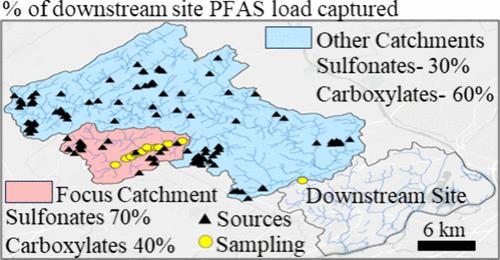Using a Time-of-Travel Sampling Approach to Quantify Per- and Polyfluoroalkyl Substances (PFAS) Stream Loading and Source Inputs in a Mixed-Source, Urban Catchment
引用次数: 0
Abstract
Understanding per- and polyfluoroalkyl substances (PFAS) mass distribution in surface and groundwater systems can support source prioritization, load reduction, and water management. Thirteen sites within an urban catchment were sampled utilizing a time-of-travel sampling approach to minimize the influence of subdaily fluctuations in mass from PFAS point sources and to quantify PFAS and ancillary chemical loads from various PFAS sources. A larger increase in perfluoroalkyl sulfonate (PFSA) loads (8 to 11 μg/s, up to 618%) than in perfluoroalkyl carboxylate (PFCA) loads (no change to 3.4 μg/s, up to 122%) was observed at sites below tributaries influenced by military bases with known groundwater discharge. Point discharges from two sewage treatment plants (STPs) resulted in increases in PFCA and PFSA loads that were similar (6 and 10 μg/s respectively) below the first STP and greater for PFCA compared to PFSA loads (23 and 13 μg/s respectively) below the second STP. Overall, percent increases in total PFAS load ranged from 20 to 277% for military base inputs and 44 to 77% for STP inputs. A focus catchment that represents only 14% (76.9 km2) of the drainage area at the most downstream site (544 km2) accounted for about 70% of PFSA and 40% of PFCA loads observed at the most downstream site. Results show that by using a time-of-travel sampling approach in mixed, urban settings with several PFAS sources, it is possible to quantify stream loads from individual PFAS sources, thereby improving source attribution and providing actionable data for water-resource managers.

在混合污染源的城市集水区采用移动时间采样法量化全氟和多氟烷基物质 (PFAS) 的溪流负荷和源头输入量
了解地表水和地下水系统中的全氟和多氟烷基物质 (PFAS) 的质量分布有助于确定污染源的优先次序、减少负荷和进行水管理。我们在一个城市集水区的 13 个地点进行了采样,采用了时间-行程采样法,以最大限度地减少全氟烷基磺酸盐点源质量亚日波动的影响,并量化各种全氟烷基磺酸盐源的全氟烷基磺酸盐和辅助化学负荷。在受已知地下水排放的军事基地影响的支流下面的地点,观察到全氟烷基磺酸盐 (PFSA) 负荷(8 至 11 μg/s,最高达 618%)比全氟烷基羧酸盐 (PFCA) 负荷(无变化至 3.4 μg/s,最高达 122%)增加得更多。两个污水处理厂 (STP) 的点排放导致 PFCA 和 PFSA 负荷增加,第一个污水处理厂下方的 PFCA 和 PFSA 负荷增幅相似(分别为 6 微克/秒和 10 微克/秒),而第二个污水处理厂下方的 PFCA 和 PFSA 负荷增幅更大(分别为 23 微克/秒和 13 微克/秒)。总体而言,军事基地输入的全氟辛烷磺酸总负荷增加了 20% 到 277%,而污水处理厂输入的全氟辛烷磺酸总负荷增加了 44% 到 77%。一个仅占最下游站点(544 平方公里)排水面积 14% (76.9 平方公里)的重点集水区约占最下游站点观测到的 PFSA 负荷的 70% 和 PFCA 负荷的 40%。研究结果表明,在有多个全氟辛烷磺酸来源的混合城市环境中采用时间行程采样法,可以量化各个全氟辛烷磺酸来源的溪流负荷,从而改进来源归因,并为水资源管理者提供可操作的数据。
本文章由计算机程序翻译,如有差异,请以英文原文为准。
求助全文
约1分钟内获得全文
求助全文

 求助内容:
求助内容: 应助结果提醒方式:
应助结果提醒方式:


